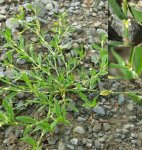Highlander bird (sporish) - polygonum aviculare l.
Buckwheat family - Polygonaceae
Botanical characteristics. Annual herbaceous plant.
The root is thin, woody. Stem is elastic, thin, supine or upright, branching, densely covered with reed leaves and thin pleated funnels. Flowers are small, barely noticeable, pinkish in the axils of leaves. Fruits are black matte trihedral nuts. Blossoms throughout the summer, fructifies until late autumn .
Spread. Ubiquitously grows literally under your feet. Sporishem overgrown village streets, stadiums, airfields, wastelands, park alleys and forest paths.
Used parts of the plant. Raw material for medicinal purposes are the roots and the aerial part of the plant, collected in the usual way. The plant is pulled out from the root or the aerial part is collected at the beginning of flowering, when the stems did not have time to harden.
Chemical composition. The highlander's roots contain anthocyanins, anthraquinones: chrysofanol, emodin and its glycosides. The aerial part contains carbohydrates (glucose, fructose, sucrose), phenol carboxylic acids (coffee, gallic, malic, salicylic, coumaric, chlorogenic, formic, valeric, acetic), trace elements (iron, copper, vanadium, magnesium, calcium, silver, silicon (Up to 4.5%), vitamins (ascorbic acid, carotene), coumarins (umbelliferone, scopoletin), tartaric substances of the pyrocatechol group, flavonoids (quercetin, isoramnetin, aviculary, quercitrin, hyperin) .The flowers contain flavones, the seeds are fatty oil.
Application. Grassgrass is used as anti-inflammatory, antispasmodic, antipyretic, diuretic, choleretic, antiseptic, hemostatic, astringent, wound-healing, diaphoretic, laxative, hypotensive. Decoctions and infusions of the aerial part are used for colds, bronchitis, tuberculosis, bronchial asthma, diseases of the gastrointestinal tract, hemorrhoids, diseases of the kidneys and urinary tracts, long-term healing wounds and ulcers, tumors, with bruises as an analgesic. Experimental studies have established that the flavonoid compounds of silicon and tannic substances of the mountaineer reduce the permeability of the walls of blood vessels, increase blood coagulability. All preparations of the mountaineer of the bird positively influence the function of the gastrointestinal tract, interfere with the formation of urinary stones, have antimicrobial, anti-inflammatory, astringent and diuretic properties.
Recently, the birdwalker has been used to treat tumors of various origins; He is a member of the Zdrenko collection, used to treat malignant tumors; Is an integral part of the fees used in the treatment of colds, peptic ulcer, headache, kidney disease, liver, as choleretic, in diseases of the urinary tract; Is part of "Breast tea", used in whooping cough, other diseases accompanied by cough. Highlander is used for infertility, metabolic disorders, hypertension.
In the experiment, the mountaineer's preparations lower the blood pressure, speed up the heart rate. Fresh juice has a high phytoncidal activity.
In Tibetan medicine, mountaineer drugs are used for heart disease, bleeding, as an antimicrobial agent.
In China, the mountaineer's decoction is treated with neurasthenia, used as a tonic in the weakened state after the illness, antihelminthic, diuretic, for the treatment of skin diseases.
Preparation
- To get the broth, take 20 g of the aboveground part or roots, chop, pour boiling water, insist on a boiling water bath for 30 minutes, cool for 10 minutes, filter. Take should be 2 tbsp. Spoon 2-3 times a day for 30 minutes before meals.
- Fresh juice of flowering plants take 1 second each. Spoon 3 times a day or externally in the treatment of skin diseases, as lotions and compresses.
Contraindications. Pregnancy (acts abortively).





Comments
Commenting on, remember that the content and tone of your message can hurt the feelings of real people, show respect and tolerance to your interlocutors even if you do not share their opinion, your behavior in the conditions of freedom of expression and anonymity provided by the Internet, changes Not only virtual, but also the real world. All comments are hidden from the index, spam is controlled.